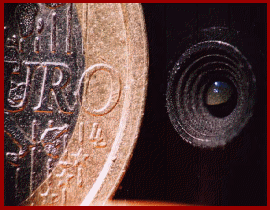| ||||||||||||||||||||||||||||||
Welcome to the | ||||||||||||||||||||||||||||||
 | ||||||||||||||||||||||||||||||
 | ||||||||||||||||||||||||||||||
Photo above shows the front of a 4mm pinhole lens, next to a Euro coin (equiv. size to a Pound or US Quarter Dollar) | ||||||||||||||||||||||||||||||
There are in fact two specific types of pinhole lens; the first are the basic lenses, either ‘flat’ or ‘domed’ which can look through a hole barely 2mm in diameter, and which are exclusively fitted onto Printed Circuit Board (PCB) cameras. This type is generally of average perormance, and in terms of operation, is really only ideal for evidential quality images at relatively short distances from the camera. The other type, which have in fact been around for very many years, are proper interchangeable optics, manufactured in three specific sizes. Both lenses were originally designed for the 2/3” format, and can therefore be used on 1/2” and 1/3” (and if you can find a camera to accept it, 1/4" ...) as well. The standard unit is a straight pinhole, which when fitted to an average camera, will result in a package some 12” or 300mm in length. The alternative version of this lens is the ‘right angle’ design, which has the ability to look sideways, albeit that the resulting image is reversed. The more widely used optic is the 6.2mm (f2) straight pinhole, which was designed for use on the 1/2” format, so again it can also be fitted on 1/3” or 1/4" if required. Finally, the most recently introduced interchangeable pinhole is a 4mm f2, which is for the 1/3” (and 1/4") format. Now, depending on which lens is selected, the actual hole the lens needs to look through is between 2.5mm and 4mm in diameter. One interesting point is that both the 9mm and the 6.2mm lenses can easily be fitted with X2 range extenders, to make them into 'Telephoto' optics, which increase the scope for deploying cameras away from the target area. It is important though to make sure that a CS mount extender is only ever used with a CS mount lens, and the C mount with .....the C mount; mix them up, and it ain’t gonna work.
| ||||||||||||||||||||||||||||||
 | ||||||||||||||||||||||||||||||
IMPORTANT: No material may be reproduced, copied or redistributed from this site, © doktorjon.co.uk 2004 - 2008 Homepage...:...Gateway...:...Technical Gateway....:....Quickfind Index....:....Equipment Directory | ||||||||||||||||||||||||||||||

